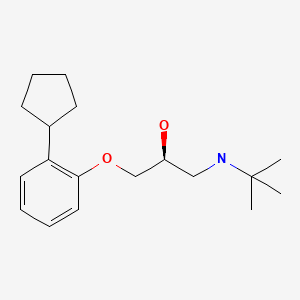CASRN: 36507-48-9

Drug Levels and Effects
Summary of Use during Lactation
Penbutolol is not marketed in the United States. Based on its physicochemical properties, penbutolol appears to present a low-risk to the breastfed infant. Because there is no published experience with penbutolol during breastfeeding, other agents may be preferred, especially while nursing a newborn or preterm infant.
Drug Levels
The excretion of beta-adrenergic blocking drugs into breastmilk is largely determined by their protein binding. Those with low binding are more extensively excreted into breastmilk.[1] Accumulation of the drugs in the infant is related to the fraction excreted in urine. With 80 to 90% protein binding, 5% renal excretion and a moderate half-life, penbutolol presents a low risk for accumulation in infants.
Maternal Levels. Relevant published information was not found as of the revision date.
Infant Levels. Relevant published information was not found as of the revision date.
Effects in Breastfed Infants
Relevant published information on penbutolol was not found as of the revision date. A study of mothers taking beta-blockers during nursing found a numerically, but not statistically significant increased number of adverse reactions in those taking any beta-blocker. Although the ages of infants were matched to control infants, the ages of the affected infants were not stated. None of the mothers were taking penbutolol.[2]
Effects on Lactation and Breastmilk
Relevant published information on the effects of beta-blockade or penbutolol during normal lactation was not found as of the revision date. A study in 6 patients with hyperprolactinemia and galactorrhea found no changes in serum prolactin levels following beta-adrenergic blockade with propranolol.[3]
Alternate Drugs to Consider
References
- 1.
- Riant P, Urien S, Albengres E, et al. High plasma protein binding as a parameter in the selection of betablockers for lactating women. Biochem Pharmacol 1986;35:4579-81. [PubMed: 2878668]
- 2.
- Ho TK, Moretti ME, Schaeffer JK, et al. Maternal beta-blocker usage and breast feeding in the neonate. Pediatr Res 1999;45 (4, pt. 2):67A. doi:10.1203/00006450-199904020-00402 [CrossRef]
- 3.
- Board JA, Fierro RJ, Wasserman AJ, et al. Effects of alpha- and beta-adrenergic blocking agents on serum prolactin levels in women with hyperprolactinemia and galactorrhea. Am J Obstet Gynecol 1977;127:285-7. [PubMed: 556882]
Substance Identification
Substance Name
Penbutolol
CAS Registry Number
36507-48-9
Drug Class
Breast Feeding
Lactation
Milk, Human
Antihypertensive Agents
Adrenergic Beta-Antagonists
Antiarrhythmics
Disclaimer: Information presented in this database is not meant as a substitute for professional judgment. You should consult your healthcare provider for breastfeeding advice related to your particular situation. The U.S. government does not warrant or assume any liability or responsibility for the accuracy or completeness of the information on this Site.
Publication Details
Publication History
Last Revision: August 15, 2024.
Copyright
Attribution Statement: LactMed is a registered trademark of the U.S. Department of Health and Human Services.
Publisher
National Institute of Child Health and Human Development, Bethesda (MD)
NLM Citation
Drugs and Lactation Database (LactMed®) [Internet]. Bethesda (MD): National Institute of Child Health and Human Development; 2006-. Penbutolol. [Updated 2024 Aug 15].